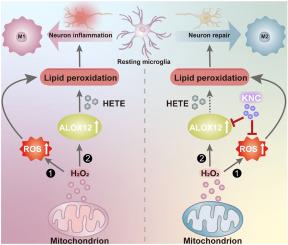KNC nanozyme repairs hypoxia ischemia brain damage through ALOX12 mediated lipid peroxidation inhibition
IF 18
1区 医学
Q1 ENGINEERING, BIOMEDICAL
引用次数: 0
Abstract
Hypoxia-Ischemia Brain Damage (HIBD) results in a widespread neuronal damage and permanent brain tissue injury due to the severe reactive oxygen species (ROS) boost induced neuroinflammation. In this work, a K doped N-C based nanozyme was fabricated for scavenging ROS. KNC could impair ROS production and M1 polarization in microglia. Beneficial from these contents, the brain damage was mitigated in HIBD rats, which was proved by the increased regional blood flow, decreased pro-inflammatory microglia and astrocyte activation. The learning and memory capabilities were restored after applying with KNC post HIBD, which was ascribed to the diminished HI-induced dendritic spine loss in hippocampal regions. RNA-seq revealed that decreased ALOX12 expression is one of the clues of neuronal protection. KNC could combine with ALOX12 and further inhibit the lipid peroxidation. These two clues obtain KNC with superior ability of inhibition of ROS boost induced brain damage post HIBD. This nanozyme provided a potential strategies and new idea of HIBD therapy.

KNC纳米酶通过ALOX12介导的脂质过氧化抑制修复缺氧缺血脑损伤
缺氧缺血性脑损伤(HIBD)由于活性氧(ROS)刺激引起的神经炎症导致广泛的神经元损伤和永久性脑组织损伤。本文制备了一种K掺杂N-C基纳米酶,用于清除活性氧。KNC可以抑制小胶质细胞中ROS的产生和M1的极化。得益于这些成分,HIBD大鼠的脑损伤得到了减轻,这可以通过增加局部血流量,减少促炎小胶质细胞和星形胶质细胞的激活来证明。在HIBD后应用KNC后,学习和记忆能力恢复,这归因于hi诱导的海马区域树突棘损失减少。RNA-seq显示ALOX12表达降低是神经元保护的线索之一。KNC可与ALOX12结合,进一步抑制脂质过氧化。这两条线索表明KNC具有较强的抑制ROS增强引起的HIBD后脑损伤的能力。这种纳米酶为HIBD的治疗提供了一种潜在的策略和新思路。
本文章由计算机程序翻译,如有差异,请以英文原文为准。
求助全文
约1分钟内获得全文
求助全文
来源期刊

Bioactive Materials
Biochemistry, Genetics and Molecular Biology-Biotechnology
CiteScore
28.00
自引率
6.30%
发文量
436
审稿时长
20 days
期刊介绍:
Bioactive Materials is a peer-reviewed research publication that focuses on advancements in bioactive materials. The journal accepts research papers, reviews, and rapid communications in the field of next-generation biomaterials that interact with cells, tissues, and organs in various living organisms.
The primary goal of Bioactive Materials is to promote the science and engineering of biomaterials that exhibit adaptiveness to the biological environment. These materials are specifically designed to stimulate or direct appropriate cell and tissue responses or regulate interactions with microorganisms.
The journal covers a wide range of bioactive materials, including those that are engineered or designed in terms of their physical form (e.g. particulate, fiber), topology (e.g. porosity, surface roughness), or dimensions (ranging from macro to nano-scales). Contributions are sought from the following categories of bioactive materials:
Bioactive metals and alloys
Bioactive inorganics: ceramics, glasses, and carbon-based materials
Bioactive polymers and gels
Bioactive materials derived from natural sources
Bioactive composites
These materials find applications in human and veterinary medicine, such as implants, tissue engineering scaffolds, cell/drug/gene carriers, as well as imaging and sensing devices.
 求助内容:
求助内容: 应助结果提醒方式:
应助结果提醒方式:


